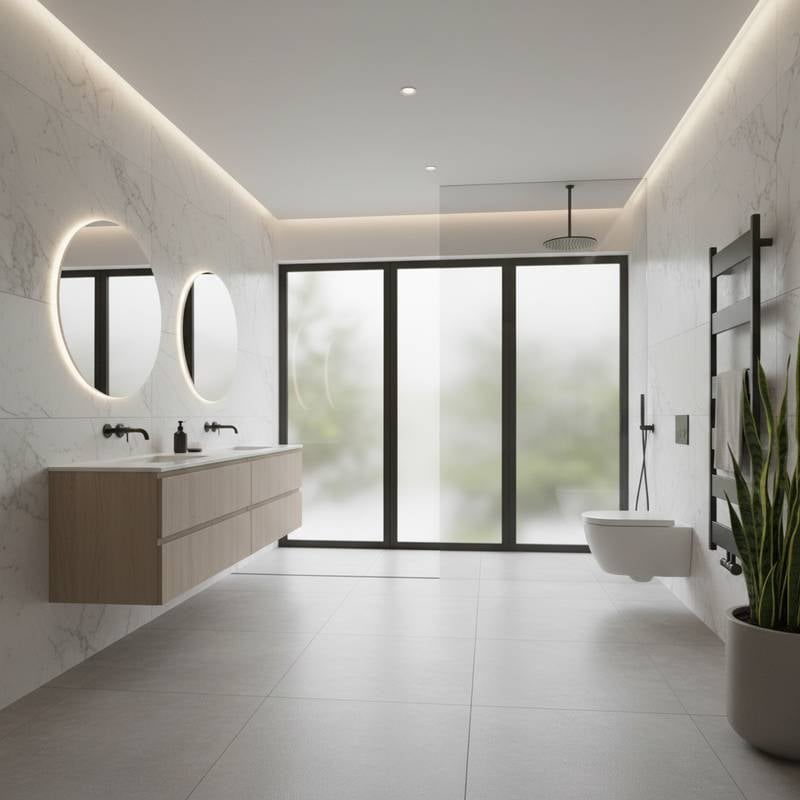Top Sustainable Design Trends for Custom Homes in 2025
Sustainable design is no longer a niche feature in custom home building. Homeowners are prioritizing efficiency, resilience, and long-term comfort, making eco-conscious choices a standard expectation. From material selection to energy systems, the newest trends combine style with performance. This guide highlights the top sustainable design directions shaping custom homes in 2025 and offers practical insight on costs, benefits, and when to bring in a professional.
Energy-Efficient Building Envelopes
A high-performance building envelope is one of the most effective ways to reduce energy use. This includes insulation, windows, and air sealing.
Why it matters: A tightly sealed home retains conditioned air more effectively, reducing heating and cooling costs.
Cost and ROI: Upgraded insulation and windows can cost between $8,000 and $20,000 depending on size and materials. Homeowners often see 10 to 20 percent energy savings annually.
DIY vs Pro: Air sealing around doors and ducts can be a manageable project. Large-scale insulation upgrades or triple-pane window installations require professionals due to code and safety requirements.
Tips: Use spray foam insulation in attics and basements. Choose windows with low-emissivity coatings to block heat gain.
Solar Integration with Storage
Solar panels continue to grow in popularity, but pairing them with battery storage creates true independence.
Why it matters: Solar plus storage lets you use electricity at night, during outages, or when grid rates are high.
Cost and ROI: A full system including panels and batteries typically ranges from $18,000 to $35,000 before incentives. Payback is often reached in 7 to 12 years depending on local energy rates.
DIY vs Pro: Solar and battery installation is not a DIY project. It requires licensed electricians and inspection approvals.
Tips: Position panels on south-facing roofs without shade. Consider lithium-iron phosphate batteries for longer lifespans and higher safety ratings.
Biophilic Interior Design
Designers are weaving natural elements into living spaces to improve well-being and reduce stress.
Why it matters: Studies show that natural textures, indoor greenery, and daylight access improve mood and productivity.
Cost and ROI: Adding skylights ranges from $1,200 to $3,000 each. Interior plants and natural finishes are lower-cost upgrades but can raise resale appeal.
DIY vs Pro: Plant walls and simple wood finishes can be homeowner projects. Structural skylight installation requires professional help.
Tips: Use reclaimed wood for accent walls. Add large windows to maximize natural light. Choose low-maintenance indoor plants like snake plants or ferns.
Water Conservation Systems
Smart water management is becoming a core part of sustainable homes.
Why it matters: Drought conditions and rising utility costs push homeowners to conserve water without giving up comfort.
Cost and ROI: Rainwater harvesting systems average $2,000 to $7,000. Greywater recycling for irrigation can add $5,000 or more. Lower water bills help offset costs.
DIY vs Pro: Installing low-flow fixtures is DIY-friendly. Greywater systems and underground cisterns require professional design and permits.
Tips: Select faucets with WaterSense labels. Use drip irrigation in landscaping to reduce outdoor water waste.
Reclaimed and Low-Carbon Materials
Homeowners are seeking materials with lower environmental footprints while still delivering durability.
Why it matters: Reclaimed wood, recycled steel, and low-carbon concrete reduce the emissions tied to construction.
Cost and ROI: Reclaimed wood flooring may range from $5 to $15 per square foot. Low-carbon concrete can add 2 to 5 percent to material costs but improves sustainability credentials.
DIY vs Pro: Salvaging and refinishing wood can be manageable, but structural concrete mixes should only be handled by contractors.
Tips: Source reclaimed flooring from local suppliers to cut transport emissions. Ask contractors about low-carbon concrete mixes that use fly ash or slag.
Smart Home Energy Management
Technology is helping homeowners track and reduce energy use in real time.
Why it matters: Smart systems adjust heating, cooling, and lighting automatically, cutting waste and increasing comfort.
Cost and ROI: Smart thermostats cost around $200 to $400 with potential savings of 8 to 12 percent on utility bills. Whole-home energy management systems can cost $2,000 to $5,000.
DIY vs Pro: Many smart thermostats and plugs are simple to install. Larger systems that integrate with solar or HVAC require professional setup.
Tips: Choose devices compatible with your existing HVAC and solar systems. Set schedules for lighting to reduce unnecessary energy use.
Money-Saving Ideas for Sustainable Homes
- Combine federal and local incentives when investing in solar or efficient upgrades.
- Phase projects over time, starting with the highest energy-saving options like insulation.
- Use reclaimed or surplus building materials from local suppliers at reduced costs.
- Bundle projects together to lower labor costs, such as upgrading insulation while replacing siding.
When to Hire a Professional
Hire a professional when:
- Structural work or electrical systems are involved.
- A project requires permits, such as solar or greywater systems.
- You are unsure about material safety, like reclaimed wood that may contain lead paint.
When evaluating contractors, request multiple quotes, ask about past sustainable projects, and verify certifications in energy-efficient or green building practices.
FAQs
What is the most cost-effective sustainable upgrade?
Improving insulation and sealing air leaks typically offers the fastest payback.
Do sustainable homes appraise higher?
Yes, homes with energy-efficient features often appraise higher and sell more quickly.
Which roofing materials are most sustainable?
Metal roofs and recycled-content shingles offer durability and recyclability.
Can older homes be retrofitted with these trends?
Yes, many sustainable features like insulation, smart systems, and solar can be added to existing homes.
How much maintenance do green features require?
Most require little upkeep beyond standard care, though solar systems may need occasional cleaning and inspections.
Living with Your Sustainable Design
Building a sustainable custom home is a long-term investment in comfort, value, and environmental responsibility. By selecting efficient systems, durable materials, and water-saving technologies, you create a home that reduces costs and enhances daily living. Plan upgrades carefully, weigh DIY against professional installation, and take advantage of available incentives. With thoughtful choices, your custom home will remain efficient, resilient, and stylish for many years to come.











